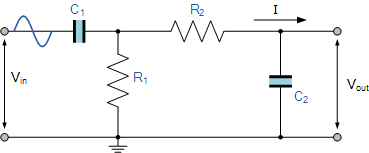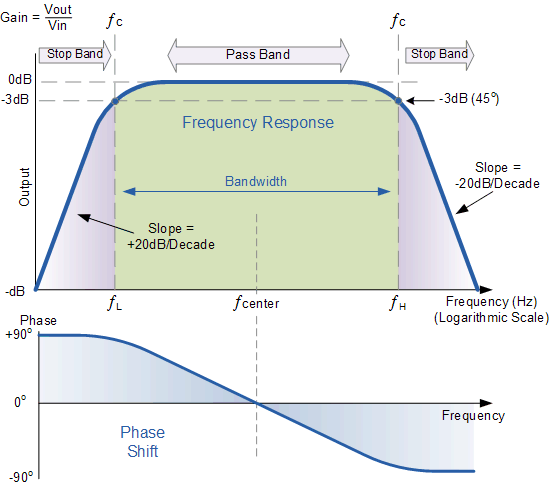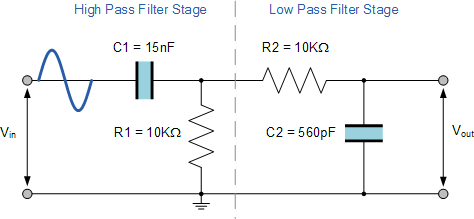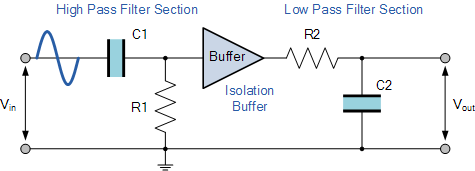[模拟电路] 2、Passive Band Pass Filter
note: Some articles are very good in http://www.electronics-tutorials.ws/,I share them in the Cnblog so that Chinese hardware engineers can enjoy and learn.
The cut-off frequency or ƒc point in a simple RC passive filter can be accurately controlled using just a single resistor in series with a non-polarized(非极性) capacitor, and depending upon which way around they are connected, we have seen that either a Low Pass or a High Pass filter is obtained.
One simple use for these types of passive filters is in audio amplifier applications or circuits such as in loudspeaker crossover filters(扬声器分频滤波器) or pre-amplifier tone controls(前置放大器音色控制). Sometimes it is necessary to only pass a certain range of frequencies that do not begin at 0Hz, (DC) or end at some upper high frequency point but are within a certain range or band of frequencies, either narrow or wide.
By connecting or “cascading” together(连接或级联) a single Low Pass Filter circuit with a High Pass Filter circuit, we can produce another type of passive RC filter that passes a selected range or “band” of frequencies that can be either narrow or wide while attenuating all those outside of this range. This new type of passive filter arrangement produces a frequency selective filter known commonly as a Band Pass Filter or BPF for short.
Band Pass Filter Circuit

Unlike a low pass filter that only pass signals of a low frequency range or a high pass filter which pass signals of a higher frequency range, a Band Pass Filters passes signals within a certain “band” or “spread” of frequencies without distorting(扭曲) the input signal or introducing(引入) extra noise. This band of frequencies can be any width and is commonly known as the filters Bandwidth.
Then for widely spread frequencies, we can simply define the term “bandwidth”, BW as being the difference between the lower cut-off frequency ( ƒcLOWER ) and the higher cut-off frequency ( ƒcHIGHER ) points. In other words, BW = ƒH – ƒL. Clearly for a pass band filter to function correctly, the cut-off frequency of the low pass filter must be higher than the cut-off frequency for the high pass filter.
The “ideal” Band Pass Filter(理想带通滤波器) can also be used to isolate or filter out(隔离或滤除) certain frequencies that lie within a particular(特定的) band of frequencies, for example, noise cancellation(噪声消除). Band pass filters are known generally as second-order(二阶) filters, (two-pole) because they have “two” reactive component(活性原件), the capacitors, within their circuit design. One capacitor in the low pass circuit and another capacitor in the high pass circuit.
Frequency Response of a 2nd Order Band Pass Filter.

The Bode Plot(波特图) or frequency response curve(频率响应曲线) above shows the characteristics of the band pass filter. Here the signal is attenuated(衰减) at low frequencies with the output increasing at a slope of +20dB/Decade (6dB/Octave)(随着+20dB/Decade的坡度衰减)until the frequency reaches the “lower cut-off” point ƒL. At this frequency the output voltage is again 1/√2 = 70.7% of the input signal value or -3dB (20 log (Vout/Vin)) of the input.
The output continues at maximum gain(增益) until it reaches the “upper cut-off” point ƒHwhere the output decreases at a rate of -20dB/Decade (6dB/Octave) attenuating any high frequency signals. The point of maximum output gain is generally the geometric mean of the two -3dB value between the lower and upper cut-off points(最大输出增益点一般是两个在最低和最高截止点之间值为-3dB的频率的几何平均) and is called the “Centre Frequency” or “Resonant Peak(共振峰)” value ƒr. This geometric mean value is calculated as being ƒr 2 = ƒ(UPPER) x ƒ(LOWER).
A band pass filter is regarded as a second-order (two-pole) type filter because it has “two” reactive components within its circuit structure, then the phase angle will be twice that of the previously seen first-order filters, ie, 180o. The phase angle of the output signal LEADS that of the input by +90o up to the centre or resonant frequency, ƒrpoint were it becomes “zero” degrees (0o) or “in-phase” and then changes to LAG the input by -90o as the output frequency increases.
The upper and lower cut-off frequency points for a band pass filter can be found using the same formula(公式) as that for both the low and high pass filters, For example.

Then clearly, the width of the pass band of the filter can be controlled by the positioning of the two cut-off frequency points of the two filters.
Band Pass Filter Example No1.
A second-order band pass filter is to be constructed using RC components that will only allow a range of frequencies to pass above 1kHz (1,000Hz) and below 30kHz (30,000Hz). Assuming that both the resistors have values of 10kΩ´s, calculate the values of the two capacitors required.
The High Pass Filter Stage.
The value of the capacitor C1 required to give a cut-off frequency ƒL of 1kHz with a resistor value of 10kΩ is calculated as:

Then, the values of R1 and C1 required for the high pass stage to give a cut-off frequency of 1.0kHz are: R1 = 10kΩ´s and C1 = 15nF.
The Low Pass Filter Stage.
The value of the capacitor C2 required to give a cut-off frequency ƒH of 30kHz with a resistor value of 10kΩ is calculated as:

Then, the values of R2 and C2 required for the low pass stage to give a cut-off frequency of 30kHz are, R = 10kΩ´s and C = 510pF. However, the nearest preferred value of the calculated capacitor value of 510pF is 560pF so this is used instead.
With the values of both the resistances R1 and R2 given as 10kΩ, and the two values of the capacitors C1 and C2 found for both the high pass and low pass filters as 15nF and 560pF respectively, then the circuit for our simple passive Band Pass Filter is given as.
Completed Band Pass Filter Circuit

Band Pass Filter Resonant Frequency
We can also calculate the “Resonant” or “Centre Frequency” (ƒr) point of the band pass filter were the output gain is at its maximum or peak value. This peak value is not the arithmetic average of the upper and lower -3dB cut-off points as you might expect but is in fact the “geometric” or mean value. This geometric mean value is calculated as being ƒr 2 = ƒc(UPPER) x ƒc(LOWER) for example:
Centre Frequency Equation

- Where, ƒr is the resonant or centre frequency
- ƒL is the lower -3dB cut-off frequency point
- ƒH is the upper -3db cut-off frequency point
and in our simple example above, the calculated cut-off frequencies were found to be ƒL= 1,060 Hz and ƒH = 28,420 Hz using the filter values.
Then by substituting these values into the above equation gives a central resonant frequency of:

Band Pass Filter Summary
A simple passive Band Pass Filter can be made by cascading together a single Low Pass Filter with a High Pass Filter. The frequency range, in Hertz, between the lower and upper -3dB cut-off points of the RC combination is know as the filters “Bandwidth”.
The width or frequency range of the filters bandwidth can be very small and selective, or very wide and non-selective depending upon the values of R and C used.
The centre or resonant frequency point is the geometric mean of the lower and upper cut-off points. At this centre frequency the output signal is at its maximum and the phase shift of the output signal is the same as the input signal.
The amplitude of the output signal from a band pass filter or any passive RC filter for that matter, will always be less than that of the input signal. In other words a passive filter is also an attenuator giving a voltage gain of less than 1 (Unity). To provide an output signal with a voltage gain greater than unity, some form of amplification is required within the design of the circuit.(无源带通滤波器输出小于输入,想要增益大于1的带通滤波器就要设计一种新的电路了)
A Passive Band Pass Filter is classed as a second-order type filter because it has two reactive components within its design, the capacitors. It is made up from two single RC filter circuits that are each first-order filters themselves.
If more filters are cascaded together the resulting circuit will be known as an “nth-order” filter where the “n” stands for the number of individual reactive components and therefore poles within the filter circuit. For example, filters can be a 2nd-order, 4th-order, 10th-order, etc.
The higher the filters order the steeper will be the slope(斜率) at n times -20dB/decade. However, a single capacitor value made by combining together two or more individual capacitors is still one capacitor.
Our example above shows the output frequency response curve for an “ideal” band pass filter with constant gain in the pass band and zero gain in the stop bands. In practice(实际中) the frequency response of this Band Pass Filter circuit would not be the same as the input reactance of the high pass circuit would affect the frequency response of the low pass circuit (components connected in series or parallel组件的串并联) and vice versa(高通滤波器的输入电抗将会影响低通滤波器的频率响应,反之亦然). One way of overcoming this would be to provide some form of electrical isolation(隔离) between the two filter circuits as shown below.
Buffering Individual Filter Stages

One way of combining amplification and filtering into the same circuit would be to use an Operational Amplifier or Op-amp, and examples of these are given in the Operational Amplifier section. In the next tutorial we will look at filter circuits which use an operational amplifier within their design to not only to introduce gain but provide isolation between stages. These types of filter arrangements are generally known as Active Filters.
@beautifulzzzz
智能硬件、物联网,热爱技术,关注产品
博客:http://blog.beautifulzzzz.com
sina:http://weibo.com/beautifulzzzz?is_all=1
[模拟电路] 2、Passive Band Pass Filter的更多相关文章
- Sallen-Key Active Butterworth Low Pass Filter Calculator
RC 2nd Order Passive Low Pass Filter The cut-off frequency of second order low pass filter is given ...
- 模拟电路"虚短" & "虚断"
<虚短 & 虚断> 运算放大器组成的电路五花八门,令人眼花瞭乱,是模拟电路中学习的重点.遍观所有模拟电子技朮的书籍和课程,在介绍运算放大器电路的时候,无非是先给电路来个定性,比如这 ...
- 初级模拟电路:3-1 BJT概述
回到目录 1. 名称由来 BJT的全称是双极性结型晶体管(Bipolar Junction Transistor),国内俗称三极管.其实,在英语中,三极管(triode)特指以前的真空电子管形式的 ...
- 初级模拟电路:4-1 BJT交流分析概述
回到目录 BJT晶体管的交流分析(也叫小信号分析)是模拟电路中的一个难点,也可以说是模电中的一个分水岭.如果你能够把BJT交流分析的原理全都搞懂,那之后的学习就是一马平川了.后面的大部分内容,诸如:场 ...
- 【SCALA】3、模拟电路
Simulation package demo17 abstract class Simulation { type Action = () => Unit case class WorkIte ...
- 初级模拟电路:1-2 PN结与二极管
回到目录 1. 掺杂半导体 上面我们分析了本征半导体的导电情况,但由于本征半导体的导电能力很低,没什么太大用处.所以,一般我们会对本征半导体材料进行掺杂,即使只添加了千分之一的杂质,也足以改变半导 ...
- 初级模拟电路:4-3 BJT晶体管的交流建模
回到目录 1. 四种BJT模型概述 对BJT晶体管建模的基本思路就是,用电路原理中的五大基本元件(电阻.电容.电感.电源.受控源)构建一个电路,使其在一定工作条件下能等效非线性半导体器件的实际工作.一 ...
- 初级模拟电路:3-11 BJT实现电流源
回到目录 1. 恒流源 (1)简易恒流源 用BJT晶体管可以构造一个简易的恒流源,实现电路如下: 图3-11.01 前面我们在射极放大电路的分压偏置时讲过,分压偏置具有非常好的稳定性,几乎不受晶体管的 ...
- 初级模拟电路:3-2 BJT的工作原理
回到目录 和前面介绍二极管的PN结的工作原理一样,BJT的量子级工作机制也非常复杂,一般教科书上为了帮助学习者能快速理解,也都是用一种简化模型的方法来介绍BJT的工作机理,一般只需大致了解即可.只要记 ...
随机推荐
- PHP验证用户登录例子-学习笔记
1.基本流程: 2.UML类图: 3.PHP代码: 3.1 index.php <?php /** * Created by PhpStorm. * User: andy * Date: 16- ...
- Hawk 6. 编译和扩展开发
Hawk是开源项目,因此任何人都可以为其贡献代码.作者也非常欢迎使用者能够扩展出更有用的插件. 编译 编译需要Visual Stuido,版本建议使用2015, 2010及以上没有经过测试,但应该可以 ...
- jq选择器基础
Jquery $代表选择器 使用jq必须要导入jq文件 <script src="http://libs.baidu.com/jquery/2.0.0/jquery.min.js&qu ...
- input标签中button在iPhone中圆角的问题
1.问题 使用H5编写微信页面时,使用<input type="button"/>时,在Android手机中显示正常,但是在iPhone手机中则显示不正常,显示为圆角样 ...
- [笔记]kubernetes 无法启动问题
在启动kubernetes的时候报错误. ERROR: timed out for http://localhost:4001/v2/keys/ 原因是无法启动etcd, etcd 监听4001本地端 ...
- PHP 设计模式概述
一.设计模式(Design pattern)是什么? 设计模式是一套被反复使用.多数人知晓的.经过分类编目的.代码设计经验的总结.使用设计模式是为了可重用代码.让代码更容易被他人理解.保证代码可靠性. ...
- Atitit.cto 与技术总监的区别
Atitit.cto 与技术总监的区别 1. 核心区别1 2. Cto主要职责1 3. 如何提升到cto1 4. CTO五种基本的必备素质:2 5. 2 1. 核心区别 技术总监(Chief Tech ...
- oracle常用函数及示例
学习oracle也有一段时间了,发现oracle中的函数好多,对于做后台的程序猿来说,大把大把的时间还要学习很多其他的新东西,再把这些函数也都记住是不太现实的,所以总结了一下oracle中的一些常用函 ...
- 【一起学OpenFOAM】03 OpenFOAM基本使用流程
OpenFOAM初学者常常对于软件的使用流程感到很迷惑,与其他的具有GUI的CFD软件不同,OpenFOAM的所有操作均为基于文本操作,譬如说里面各种计算模型.计算参数.流程控制参数等,均为通过修改对 ...
- HTML 学习笔记 JQuery(DOM 操作2)
接着上一节的将,这一节从复制节点讲起 复制节点 继续使用之前的例子 如果单击<li>元素后 需要在复制一个<li>元素,可以使用clone()方法完成.全部代码如下 <h ...
